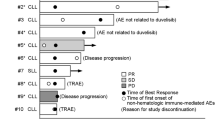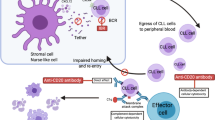Abstract
Although B-cell chronic lymphocytic leukemia (CLL) is treatable, it remains an incurable disease and most patients inevitably suffer relapse. Many therapeutic options exist for those requiring therapy, including monoclonal antibodies and stem cell transplantation, but remissions tend to last shorter in the course of the disease. Targeting the cell cycle has recently been realized to be an attractive therapeutic approach in solid and hematological malignancies, and the proliferative nature of B-CLL is increasingly accepted. Here, we report data on a phase II pilot trial with the oral mammalian target of rapamycin (mTOR) inhibitor RAD001 5 mg/daily in patients with advanced B-CLL who had progressive disease after at least two lines of treatment. After treatment of seven patients, this trial was stopped because of toxicity concerns, although some degree of activity was observed (one partial remission, three patients with stable disease). Interestingly, cyclin E expression decreased in responding patients. Further strategies of mTOR inhibition by RAD001 in B-CLL should focus on different treatment schedules, adequate anti-infectious prophylaxis, or combinations with cytotoxic drugs.


Similar content being viewed by others
References
Cheson BD, Bennett JM, Grever M et al (1996) National Cancer Institute-sponsored Working Group guidelines for chronic lymphocytic leukemia: revised guidelines for diagnosis and treatment. Blood 87:4990–4997
Reed JC (1998) Molecular biology of chronic lymphocytic leukemia. Semin Oncol 25:11–18
Messmer BT, Messmer D, Allen SL et al (2005) In vivo measurements document the dynamic cellular kinetics of chronic lymphocytic leukemia B cells. J Clin Invest 115:755–764
Ghia P, Circosta P, Scielzo C et al (2005) Differential effects on CLL cell survival exerted by different microenvironmental elements. Curr Top Microbiol Immunol 294:135–145
Schmid C, Isaacson PG (1994) Proliferation centres in B-cell malignant lymphoma, lymphocytic (B-CLL): an immunophenotypic study. Histopathology 24:445–451 doi:10.1111/j.1365–2559.1994.tb00553.x
Chiorazzi N (2007) Cell proliferation and death: forgotten features of chronic lymphocytic leukemia B cells. Best Pract Res Clin Haematol 20:399–413 doi:10.1016/j.beha.2007.03.007
Decker T, Hipp S, Ringshausen I et al (2003) Rapamycin-induced G1 arrest in cycling B-CLL cells is associated with reduced expression of cyclin D3, cyclin E, cyclin A, and survivin. Blood 101:278–285 doi:10.1182/blood-2002–01–0189
Ringshausen I, Peschel C, Decker T (2005) Mammalian target of rapamycin (mTOR) inhibition in chronic lymphocytic B-cell leukemia: a new therapeutic option. Leuk Lymphoma 46:11–19 doi:10.1080/10428190400005353
Zanesi N, Aqeilan R, Drusco A et al (2006) Effect of rapamycin on mouse chronic lymphocytic leukemia and the development of nonhematopoietic malignancies in Emu-TCL1 transgenic mice. Cancer Res 66:915–920 doi:10.1158/0008–5472.CAN-05–3426
Guertin DA, Sabatini DM (2007) Defining the role of mTOR in cancer. Cancer Cell 12:9–22 doi:10.1016/j.ccr.2007.05.008
Wanner K, Hipp S, Oelsner M et al (2006) Mammalian target of rapamycin inhibition induces cell cycle arrest in diffuse large B cell lymphoma (DLBCL) cells and sensitises DLBCL cells to rituximab. Br J Haematol 134:475–484 doi:10.1111/j.1365–2141.2006.06210.x
Hudes G, Carducci M, Tomczak P et al (2007) Temsirolimus, interferon alfa, or both for advanced renal-cell carcinoma. N Engl J Med 356:2271–2281 doi:10.1056/NEJMoa066838
Witzig TE, Geyer SM, Ghobrial I et al (2005) Phase II trial of single-agent temsirolimus (CCI-779) for relapsed mantle cell lymphoma. J Clin Oncol 23:5347–5356 doi:10.1200/JCO.2005.13.466
Yee KW, Zeng Z, Konopleva M et al (2006) Phase I/II study of the mammalian target of rapamycin inhibitor everolimus (RAD001) in patients with relapsed or refractory hematologic malignancies. Clin Cancer Res 12:5165–5173 doi:10.1158/1078–0432.CCR-06–0764
Eisen HJ, Tuzcu EM, Dorent R et al (2003) Everolimus for the prevention of allograft rejection and vasculopathy in cardiac-transplant recipients. N Engl J Med 349:847–858 doi:10.1056/NEJMoa022171
Elter T, Borchmann P, Schulz H et al (2005) Fludarabine in combination with alemtuzumab is effective and feasible in patients with relapsed or refractory B-cell chronic lymphocytic leukemia: results of a phase II trial. J Clin Oncol 23:7024–7031 doi:10.1200/JCO.2005.01.9950
Kofler DM, Mayr C, Wendtner CM (2006) Current status of immunotherapy in B cell malignancies. Curr Drug Targets 7:1371–1374 doi:10.2174/138945006778559120
Montserrat E, Moreno C, Esteve J et al (2006) How I treat refractory CLL. Blood 107:1276–1283 doi:10.1182/blood-2005–02–0819
Streit F, Armstrong VW, Oellerich M (2002) Rapid liquid chromatography-tandem mass spectrometry routine method for simultaneous determination of sirolimus, everolimus, tacrolimus, and cyclosporin A in whole blood. Clin Chem 48:955–958
Bogner C, Sandherr M, Perker M et al (2006) Cyclin E but not bcl-2, bax or mcl-1 is differentially expressed in ZAP 70-positive and ZAP 70-negative B-CLL cells. Ann Hematol 85:458–462 doi:10.1007/s00277–005–0076-y
Gotze KS, Hoffmann D, Schatzl HM et al (2007) Fatal Epstein-Barr virus-associated lymphoproliferative disorder following treatment with a novel mTOR inhibitor for relapsed chronic lymphocytic leukemia leukemia cells. Haematologica 92:1282–1283 doi:10.3324/haematol.11155
Decker T, Hipp S, Hahntow I et al (2004) Expression of cyclin E in resting and activated B-chronic lymphocytic leukaemia cells: cyclin E/cdk2 as a potential therapeutic target. Br J Haematol 125:141–148 doi:10.1111/j.1365–2141.2004.04901.x
Vrhovac R, Delmer A, Tang R et al (1998) Prognostic significance of the cell cycle inhibitor p27Kip1 in chronic B-cell lymphocytic leukemia. Blood 91:4694–4700
Nourse J, Firpo E, Flanagan WM et al (1994) Interleukin-2-mediated elimination of the p27Kip1 cyclin-dependent kinase inhibitor prevented by rapamycin. Nature 372:570–573 doi:10.1038/372570a0
Dunn C, Croom KF (2006) Everolimus: a review of its use in renal and cardiac transplantation. Drugs 66:547–570 doi:10.2165/00003495–200666040–00009
Wendtner CM, Ritgen M, Schweighofer CD et al (2004) Consolidation with alemtuzumab in patients with chronic lymphocytic leukemia (CLL) in first remission—experience on safety and efficacy within a randomized multicenter phase III trial of the German CLL Study Group (GCLLSG). Leukemia 18:1093–1101 doi:10.1038/sj.leu.2403354
Thursky KA, Worth LJ, Seymour JF et al (2006) Spectrum of infection, risk and recommendations for prophylaxis and screening among patients with lymphoproliferative disorders treated with alemtuzumab*. Br J Haematol 132:3–12 doi:10.1111/j.1365–2141.2005.05789.x
Chanan-Khan A, Miller KC, Musial L et al (2006) Clinical efficacy of lenalidomide in patients with relapsed or refractory chronic lymphocytic leukemia: results of a phase II study. J Clin Oncol 24:5343–5349 doi:10.1200/JCO.2005.05.0401
Byrd JC, Lin TS, Dalton JT et al (2007) Flavopiridol administered using a pharmacologically derived schedule is associated with marked clinical efficacy in refractory, genetically high-risk chronic lymphocytic leukemia. Blood 109:399–404 doi:10.1182/blood-2006–05–020735
Del Poeta G, Del Principe MI, Buccisano F et al (2008) Consolidation and maintenance immunotherapy with rituximab improve clinical outcome in patients with B-cell chronic lymphocytic leukemia. Cancer 112:119–128 doi:10.1002/cncr.23144
Robertson MJ, Kahl BS, Vose JM et al (2007) Phase II study of enzastaurin, a protein kinase C beta inhibitor, in patients with relapsed or refractory diffuse large B-cell lymphoma. J Clin Oncol 25:1741–1746 doi:10.1200/JCO.2006.09.3146
Beuvink I, Boulay A, Fumagalli S et al (2005) The mTOR inhibitor RAD001 sensitizes tumor cells to DNA-damaged induced apoptosis through inhibition of p21 translation. Cell 120:747–759 doi:10.1016/j.cell.2004.12.040
Author information
Authors and Affiliations
Corresponding author
Additional information
T.D., M.S., and K.G. contributed to the clinical care of the patient and interpretation of data. M.O. carried out laboratory investigations and contributed to analysis of data. T.D., M.S., and C.P. designed the study. T.D. wrote the paper.
This work was supported in part by funding from Novartis Pharma.
Rights and permissions
About this article
Cite this article
Decker, T., Sandherr, M., Goetze, K. et al. A pilot trial of the mTOR (mammalian target of rapamycin) inhibitor RAD001 in patients with advanced B-CLL. Ann Hematol 88, 221–227 (2009). https://doi.org/10.1007/s00277-008-0582-9
Received:
Accepted:
Published:
Issue Date:
DOI: https://doi.org/10.1007/s00277-008-0582-9




